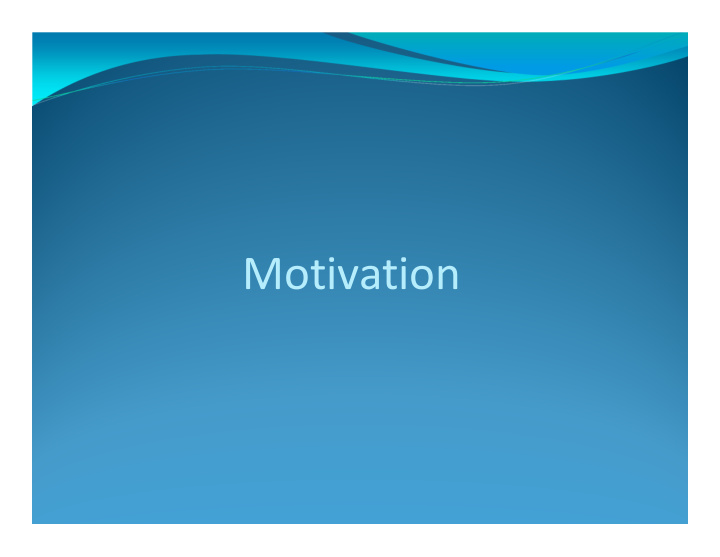



Motivation
What is Motivation? How motivated are you now? What are your thoughts as you enter the Bank daily?
Motivation � It is the driving force for you to achieve your goal! � It is an inner drive to act or behave in a certain manner. � It is psychological, and differs from one person to another. � Motivation can be Self Motivation (which is the best) or motivation by others (which at times could be temporary!) � Indian astronaut Wg. Cdr. Rakesh Sharma, when asked by the then PM Ms. Indira Gandhi about how India looked from space, replied: “Saare Jahan Se Achcha, Hindustan Hamara!”
Maslow’s theory of Needs…
Hygiene factors and Motivators � Hygiene factors: � Associated with dissatisfaction of employees. � E.g., Salary, work conditions, security, Bank’s policies, etc. � Need to be removed/eliminated/minimized to reduce dissatisfaction. However, will not ensure satisfaction! � Motivators: � Associated with satisfaction of employees. � E.g., work itself, responsibility, achievement, advancement, recognition, etc. � Increases motivation of employees and leads to better efficiency and productivity!
Macgregor’s Theories of Motivation Theory X Theory Y � Employees are naturally � Employees are self motivated. unmotivated. � Authoritarian style of � Participative style of management necessary. management works. � Employees dislike working. � They enjoy work! � They need to be directed, � They take responsibility. controlled, forced and threatened to work. � They are creative and solve � Need to be enticed to problems imaginatively. produce results.
Pygmalion Motivation � Named after G B Shaw’s play “Pygmalion” based on “My Fair Lady” where a flower girl is transformed into a sophisticated lady. � You can motivate and get better performance from people by communicating and setting High Performance Expectations! � This is their motivation to perform better!!!
Motivational Calculus � Proposed by Charles Handy, one of the most advanced Management Thinkers in the world. � You have given an important task to a colleague or team member. However, he/she does not seem to be too happy, though having the skills and energy to do it. � Why? � Handy says that the following factors apply: � a) Needs - including personality and work environment � b) Results – measurable? � c) Effectiveness – do the results meet the needs?
The Hawthorne Experiments � Elton Mayo, a researcher at Harvard, did several experiments to assess productivity of workers. � Lighting was altered several times. However, productivity went up even when lighting was made bright, or made low….it was surprising!!! � Result: Workers were motivated when they knew that they were being observed! � However, good working conditions would certainly motivate staff to perform better!
Human Motivation Theory � David McClelland proposed this theory. � You have praised a staff member during a meeting, for the excellent report that she had prepared. � However, she appears embarrassed. Why? � He proposed 3 factors for motivation: � a) Achievement – challenging tasks, often working alone, needs feedback � b) Affiliation – wants to be with a group, wants to be liked, will go with group policy � c) Power – wants to control, influence, enjoys status and winning
Progress Theory � Proposed by Teresa Amabile and Steven Kramer � “Small wins” can boost motivation and performance! � When staff take small, consistent steps forward, even in large tasks, they become more productive, creative and motivated! � Set clear Goals, allow autonomy, provide resources, allow adequate time, provide support/expertise, learn from failure , recognize and celebrate success…
Equity Theory � John Stacey Adams proposed this theory. � A fair balance (equity) between an employee’s inputs (skill, enthusiasm, hard work) and outputs (salary, benefits, intangibles) ensures a strong, productive relationship. � This motivates employees to form a loyal bond and serve the organization with contentment. � Employees are demotivated if inputs are far in excess of outputs.
Intrinsic and Extrinsic Motivators � Intrinsic Motivation is driven by the interest or enjoyment of your work itself! Employee engagement at work is high, and they tend to improve their skills and capabilities. � Extrinsic Motivation is driven by outside factors. E.g., reward or punishment, cheering of a crowd, etc. (Carrot and Stick can also work here). � Related to Push and Pull motivational factors. � Obviously, between the two, Intrinsic Motivation is better! Why?
How do I motivate my team? � Shed your ego! � Trust and believe in them. � Understand their skills and talents. � Utilise their skills and talents. � Do not be partial. Each member is different! � Communicate regularly with them, and listen well. � Empathise with them, especially during difficult situations. � Win their respect, not their fear! � Be a participative leader! Be one among them! � Rejoice in the success of the team!
How should I motivate myself? � Walk in with your head held high, greet everyone and say to yourself, “today is going to be a great day!” � Accept success with joy, and do not let it go to your head! � Accept failure with composure, and take steps to progress despite the failure! � Have a hobby! � Spend time with family. � Think of what motivates you, and go for it! � Think of what demotivates you, and avoid it! � Reward yourself for success! � Be positive, and avoid negative minded people…. � Say to yourself, “I can do it, I will do it…..”
Your task: Be self motivated. Encourage your team members to be self motivated too! Motivation, like bathing, does not last – that is why we recommend it daily!
Recommend
More recommend